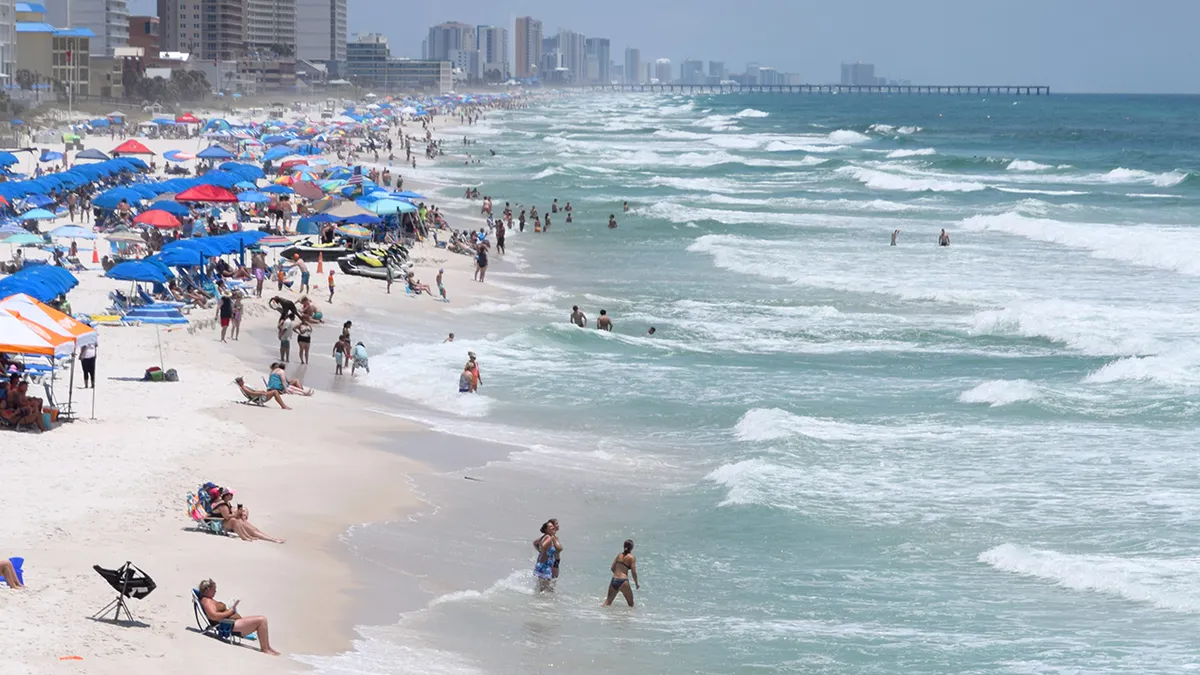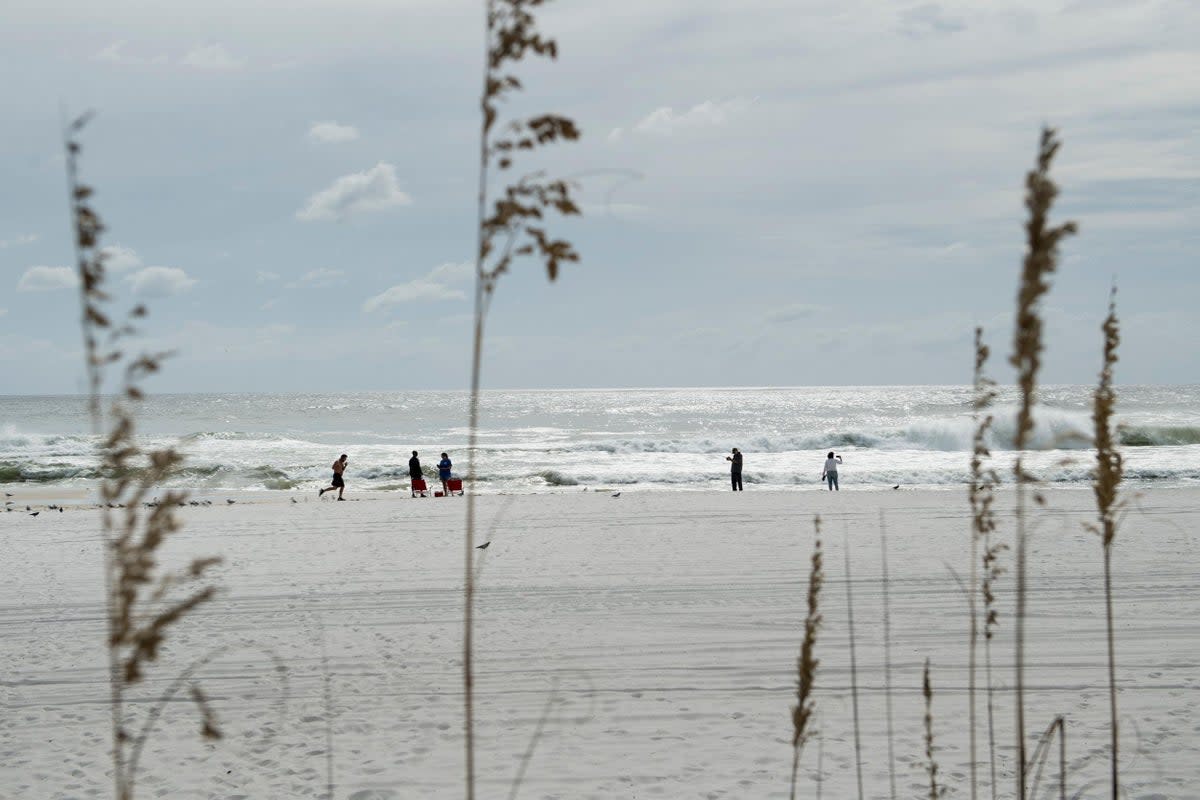Rip Current Dynamics: Panama City Beach Rip Current

Panama city beach rip current – Rip currents are powerful, narrow channels of fast-moving water that flow away from the shore, often through breaks in the sandbar. They can be difficult to spot, as they often have no visible surface features and can appear in calm waters.
The panama city beach rip current is a dangerous force that can quickly pull swimmers out to sea. The current is caused by the interaction of waves with the underwater topography of the beach. Rip currents can occur anywhere along the beach, but they are most common near jetties and piers.
If you are caught in a rip current, do not panic. Stay calm and swim parallel to the shore until you are out of the current. You can also signal for help by waving your arms or shouting.
Formation of Rip Currents
Rip currents are formed when waves break near the shore and push water towards the beach. Some of this water flows back towards the sea in a longshore current, which runs parallel to the beach. However, some of the water is trapped between the longshore current and the beach, creating a rip current that flows back towards the sea.
Panama City Beach’s infamous rip currents have claimed lives once more, reminding beachgoers of the ocean’s unforgiving nature. Meanwhile, in the world of baseball, the Dodgers and Rockies face off in a highly anticipated matchup. Dodgers vs Rockies prediction experts predict a close game, with the Dodgers holding a slight edge.
As the sun sets on Panama City Beach, the waves continue to crash against the shore, a reminder that even the most serene of settings can turn treacherous in an instant.
Characteristics of Rip Currents, Panama city beach rip current
Rip currents are typically narrow, only a few meters wide, but they can be very powerful. They can flow at speeds of up to 8 feet per second, and they can carry swimmers away from the shore very quickly.
The rip currents of Panama City Beach can be treacherous, but they’re nothing compared to the high-stakes battle between the Brewers and Padres. The latest brewers vs padres prediction has the Brewers as slight favorites, but the Padres have a history of surprising their opponents.
Back on the beach, the rip currents continue to pose a danger, but they’re also a reminder of the power of nature and the importance of respecting it.
Rip currents are often associated with certain beach conditions, such as:
- Low tide
- Large waves
- A steep underwater slope
Role of Tides, Waves, and Underwater Topography in Rip Current Formation
The tides, waves, and underwater topography all play a role in the formation of rip currents.
The unpredictable currents of Panama City Beach can be as treacherous as the Brewers vs. Padres prediction. Like the tides that relentlessly pull at the shore, the currents can swiftly drag unsuspecting swimmers into a dangerous embrace. Just as the outcome of the game remains uncertain, so too does the fate of those who dare to venture into the unforgiving waters of Panama City Beach.
- Tides: Low tide creates a steeper underwater slope, which can lead to the formation of rip currents.
- Waves: Large waves can push more water towards the shore, which can increase the strength of rip currents.
- Underwater topography: A steep underwater slope can create a channel for rip currents to flow through.
Comparison of Rip Currents to Other Types of Currents
Rip currents are different from other types of currents, such as longshore currents and tidal currents.
| Current | Direction | Speed | Width |
|---|---|---|---|
| Rip current | Away from shore | Up to 8 feet per second | A few meters |
| Longshore current | Parallel to shore | 1-2 feet per second | Tens of meters |
| Tidal current | Reverses with the tide | 1-2 feet per second | Hundreds of meters |
Rip Current Safety

Rip currents are powerful, narrow channels of fast-moving water that can pull swimmers out to sea. They are often difficult to spot, and even experienced swimmers can be caught in their grip.
The risks associated with rip currents include drowning, exhaustion, and injury. Swimmers who are caught in a rip current should not try to swim against it. Instead, they should swim parallel to the shore until they are out of the current’s pull.
Identifying Rip Currents
Rip currents can be identified by their choppy water, which is often a different color than the surrounding water. They can also be identified by the presence of a break in the line of waves.
Escaping Rip Currents
If you are caught in a rip current, do not panic. Stay calm and follow these steps:
- Do not swim against the current.
- Swim parallel to the shore until you are out of the current’s pull.
- If you are unable to swim, call for help.
Safety Tips for Swimmers, Surfers, and Other Beachgoers
To avoid being caught in a rip current, swimmers, surfers, and other beachgoers should take the following precautions:
- Swim in areas that are supervised by a lifeguard.
- Be aware of the signs of a rip current.
- Do not swim alone.
- If you are caught in a rip current, do not panic and follow the steps Artikeld above.
Rip Current Mitigation
Rip currents pose a significant hazard to beachgoers, and various methods have been employed to mitigate their impact. These methods aim to reduce the strength or frequency of rip currents, making them less dangerous for swimmers.
Jetties and Groins
Jetties and groins are structures built perpendicular to the shoreline, extending into the water. They disrupt the flow of water, causing it to slow down and deposit sediment, which can help to reduce the formation of rip currents. However, these structures can also have negative environmental impacts, such as altering the natural flow of sediment and affecting marine life.
Artificial Reefs
Artificial reefs are structures placed in the water to create a barrier that breaks up waves and reduces the strength of rip currents. They can also provide habitat for marine life and enhance the overall ecosystem. However, the effectiveness of artificial reefs in mitigating rip currents can vary depending on their size, shape, and location.
Successful Mitigation Projects
Several successful rip current mitigation projects have been implemented around the world. One example is the installation of a series of jetties at Daytona Beach, Florida. This project has significantly reduced the number of rip currents and drownings in the area.
The relentless rip currents of Panama City Beach can turn a leisurely day into a life-threatening ordeal. But before venturing into the alluring waters, it’s wise to check the panama city beach flag today for a glimpse into the current conditions.
The color of the flag serves as a warning system, providing invaluable information about the potential hazards lurking beneath the surface. By heeding the flag’s message, beachgoers can navigate the treacherous waters more safely, ensuring that their time at Panama City Beach remains a cherished memory.
